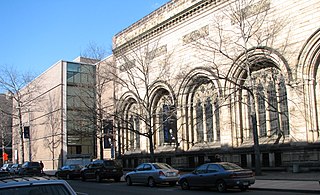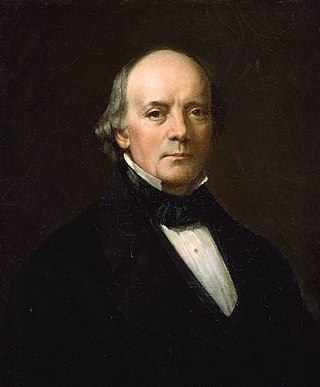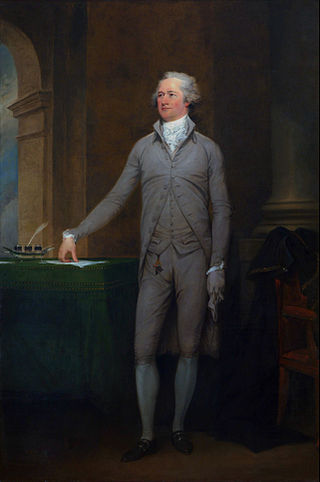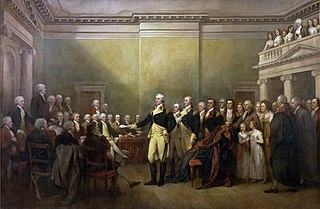
Visual art of the United States or American art is visual art made in the United States or by U.S. artists. Before colonization, there were many flourishing traditions of Native American art, and where the Spanish colonized Spanish Colonial architecture and the accompanying styles in other media were quickly in place. Early colonial art on the East Coast initially relied on artists from Europe, with John White the earliest example. In the late 18th and early 19th centuries, artists primarily painted portraits, and some landscapes in a style based mainly on English painting. Furniture-makers imitating English styles and similar craftsmen were also established in the major cities, but in the English colonies, locally made pottery remained resolutely utilitarian until the 19th century, with fancy products imported.

Gilbert Stuart was an American painter from Rhode Island Colony who is widely considered one of America's foremost portraitists. His best-known work is an unfinished portrait of George Washington, begun in 1796, which is usually referred to as the Athenaeum Portrait. Stuart retained the original and used it to paint scores of copies that were commissioned by patrons in America and abroad. The image of George Washington featured in the painting has appeared on the United States one-dollar bill for more than a century and on various postage stamps of the 19th century and early 20th century.

Charles Willson Peale was an American painter, soldier, scientist, inventor, politician, and naturalist.

John Trumbull was an American artist of the early independence period, notable for his historical paintings of the American Revolutionary War, of which he was a veteran. He has been called the "Painter of the Revolution".

Rembrandt Peale was an American artist and museum keeper. A prolific portrait painter, he was especially acclaimed for his likenesses of presidents George Washington and Thomas Jefferson. Peale's style was influenced by French neoclassicism after a stay in Paris in his early thirties.

The Yale University Art Gallery (YUAG) is the oldest university art museum in the Western Hemisphere. It houses a major encyclopedic collection of art in several interconnected buildings on the campus of Yale University in New Haven, Connecticut. Although it embraces all cultures and periods, the gallery emphasizes early Italian Renaissance painting, African sculpture, and modern art.

Harding's Gallery in Boston, Massachusetts, exhibited works by European and American artists in the 1830s-1840s. The building on School Street also housed a newspaper press; the Mercantile Library Association; the Boston Artists' Association; and artists' studios. The building's name derived from painter Chester Harding, who kept his studio there.

Joseph Wright was an American portrait painter and sculptor. He painted life portraits of George Washington and Benjamin Franklin, and was a designer of early U.S. coinage. Wright was President Washington's original choice for Chief Engraver of the U.S. Mint, but died at age 37, before being confirmed to that position.

Blueskin was a gray horse ridden by George Washington. He was one of Washington's two primary mounts during the American Revolutionary War. The horse was a half-Arabian, sired by the stallion "Ranger", also known as "Lindsay's Arabian", said to have been obtained from the Sultan of Morocco. Blueskin was a gift to Washington from Colonel Benjamin Tasker Dulany of Maryland. Dulany married Elizabeth French, a ward of Washington's, who gave her away at her wedding to Dulany on February 10, 1773.

Alexander Hamilton is a 1792 full-length portrait of Alexander Hamilton by John Trumbull. It is one of multiple paintings John Trumbull made of Alexander Hamilton.

The Death of General Mercer at the Battle of Princeton, January 3, 1777 is the title of an oil painting by the American artist John Trumbull depicting the death of the American General Hugh Mercer at the Battle of Princeton on Friday, January 3, 1777, during the American Revolutionary War. The painting was Trumbull’s first depiction of an American victory. It is one of a series of historical paintings on the war, which also includes the Declaration of Independence and The Capture of the Hessians at Trenton, December 26, 1776.

General George Washington Resigning His Commission is a large-scale oil painting by American artist John Trumbull of General George Washington resigning his commission as commander-in-chief of the Continental Army on December 23, 1783 to the Congress of the Confederation, then meeting in the Maryland State House at Annapolis, Maryland. The painting was commissioned in 1817, started in 1822, finished in 1824, and is now on view in the United States Capitol rotunda in Washington, D.C., along with three other large-scale paintings by Trumbull about the American Revolutionary War.

The Capture of the Hessians at Trenton, December 26, 1776 is the title of an oil painting by the American artist John Trumbull depicting the capture of the Hessian soldiers at the Battle of Trenton on the morning of Thursday, December 26, 1776, during the American Revolutionary War. The focus is on General George Washington aiding the mortally wounded Hessian Colonel Johann Gottlieb Rall. Nearly 900 Hessians were captured at the battle. It is one of Trumbull's series of historical paintings on the war, which also includes the Declaration of Independence and The Death of General Mercer at the Battle of Princeton, January 3, 1777. The painting is on view at the Yale University Art Gallery in New Haven, Connecticut.

General George Washington at Trenton is a large full-length portrait in oil painted in 1792 by the American artist John Trumbull of General George Washington at Trenton, New Jersey, on the night of January 2, 1777, during the American Revolutionary War. This is the night after the Battle of the Assunpink Creek, also known as the Second Battle of Trenton, and before the decisive victory at the Battle of Princeton the next day. The artist considered this portrait "the best certainly of those which I painted." The portrait is on view at the Yale University Art Gallery in New Haven, Connecticut, an 1806 gift of the Society of the Cincinnati in Connecticut. It was commissioned by the city of Charleston, South Carolina, but was rejected by the city, resulting in Trumbull painting another version.

Washington at Verplanck's Point is a full-length portrait in oil painted in 1790 by the American artist John Trumbull of General George Washington at Verplanck's Point on the North River in New York during the American Revolutionary War. The background depicts the September 14, 1782 review of Continental Army troops Washington staged there as an honor for the departing French commander Comte de Rochambeau and his army.

George Washington's resignation as commander-in-chief marked the end of Washington's military service in the American Revolutionary War and his return to civilian life at Mount Vernon.

The Death of General Montgomery in the Attack on Quebec, December 31, 1775 is an oil painting completed in 1786 by the American artist John Trumbull. It depicts American general Richard Montgomery at the Battle of Quebec during the invasion of Quebec. The painting is on view at the Yale University Art Gallery in New Haven, Connecticut. It is the second in Trumbull's series of national historical paintings on the American Revolutionary War, the first being The Death of General Warren at the Battle of Bunker's Hill, June 17, 1775.

George Washington is a large full-length oil painted by American artist John Trumbull in 1790.

George Washington's reception at Trenton was a celebration hosted by the Ladies of Trenton social club on April 21, 1789, in Trenton, New Jersey, as George Washington, then president-elect, journeyed from his home at Mount Vernon to his first inauguration in the then capital of the United States, New York City. A ceremonial triumphal arch was erected on the bridge over the Assunpink Creek to commemorate his two victories here, the Battle of Trenton on December 26, 1776 and the Battle of the Assunpink Creek on January 2, 1777.

The Passage of the Delaware is a large, Neoclassical 1819 oil-on-canvas painting by Thomas Sully. With attention to historical accuracy, the painting depicts George Washington on horseback observing the troops of the American Revolutionary Army in the process of crossing the Delaware River prior to the surprise attack on Hessian troops on December 26, 1776, at the Battle of Trenton. The image is intended to capture the moment prior to George Washington dismounting his horse and joining his army in crossing the Delaware River.


























